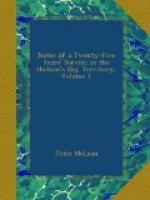The reports I have had, both from natives and white trappers, confirm the opinion that certain varieties of the fox belong to the same species,—such as the black, silver, cross, and red; all of which have been found in the same nest, but never any of the white or blue. The former, too, are distinguished for their cunning and sagacity; while the latter are very stupid, and fall an easy prey to the trapper; a circumstance of itself sufficient to prove a difference of species.
There are two varieties of the rein-deer,—the migratory, and the stationary or wood-deer: the latter is a much larger animal, but not abundant; the former are extremely numerous, migrating in herds at particular seasons, and observing certain laws on their march, from which they seldom deviate. The does make their appearance at Ungava River generally in the beginning of March, coming from the west, and directing their course over the barren grounds near the coast, until they reach George’s River, where they halt to bring forth their young, in the month of June. Meantime the bucks, being divided into separate herds, pursue a direct course through the interior, for the same river, and remain scattered about on the upper parts of it until the month of September, when they assemble, and proceed slowly towards the coast. By this time the does move onward towards the interior, the fawns having now sufficient strength to accompany them, and follow the banks of George’s River until they meet the bucks, when the rutting season commences, in the month of October; the whole then proceed together, through the interior, to the place whence they came. In the same manner, I have been informed, the deer perform their migratory circuits everywhere; observing the same order on their march, following nearly the same route unless prevented by accidental circumstances, and observing much the same periods of arrival and departure.
The colour of the rein-deer is uniformly the same, presenting no variety of “spotted black and red.” In summer it is a very dark grey, approaching to black, and light grey in winter. The colour of the doe is of a darker shade than that of the buck, whose breast is perfectly white in winter. Individuals are seen of a white colour at all seasons of the year. The bucks shed their antlers in the month of December; the does in the month of January. A few bucks are sometimes to be met with who roam about apart from the larger herds, and are in prime condition both in summer and winter. These solitaires are said to be unsuccessful candidates for the favours of the does, who, having been worsted by their more powerful rivals in contentione amoris, withdraw from the community, and assuming the cowl, ever after eschew female society; an opinion which their good condition at all seasons seems to corroborate.




